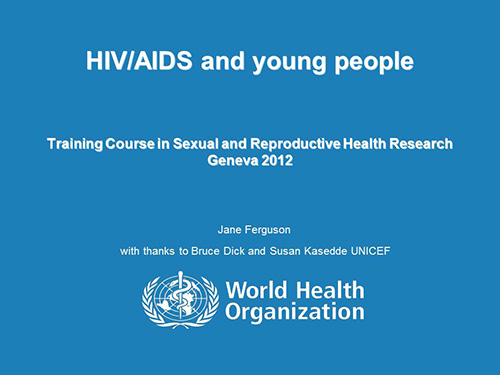Adolescent sexual and reproductive health - Course files
HIV/AIDS and young people
Jane Ferguson
From Research to Practice: Training Course in Sexual and Reproductive Health Research 2012
October 1, 2012 - Geneva
Download the complete document
Ferguson J. HIV/AIDS and young people. Paper presented at: Training Course in Sexual and Reproductive Health Research; 2012 Oct 1; Geneva. Available from: https://www.gfmer.ch/SRH-Course-2012/adolescent-health/HIV-AIDS-young-people-Ferguson-2012.htm
Topics
The topics covered in the module are:
- Why is it important to focus on HIV in young people?
- What is the scope of the HIV epidemic in young people?
- What are the special needs of adolescents living with HIV (ALHIV)?
- What are achievements and challenges of the response to HIV and young people?
Essential reading
A series of seven Guidance Briefs has been developed by the Inter-Agency Task Team (IATT) on HIV and Young People to assist United Nations Country Teams (UNCT) and UN Theme Groups on HIV/AIDS in providing guidance to their staffs, governments, donors and civil society on the specific actions that need to be in place to respond effectively to HIV among young people.
The Briefs contains a global overview, a separate Brief for most-at-risk young people and five others on HIV interventions among young people provided through different settings /sectors: community, education, health, humanitarian emergencies and the workplace.
The purpose of these Briefs is to help decision makers understand what needs to be implemented, based on the latest global evidence on effective interventions for young people.
The Briefs provide an overview of evidence-informed interventions (not a blueprint for national programmes) in response to specific epidemic scenarios in different countries.
IMAI one-day orientation on adolescents living with WHO. WHO. Geneva. 2010.
IMAI one-day orientation on adolescents living with HIVThe number of adolescents living with HIV is increasing with improvements in access to treatment for children who are infected perinatally, and as more adolescents who acquire HIV during adolescence learn about their status as a result of better access to HIV testing. Many countries are now facing the challenges posed by adolescents living with HIV, and health workers are looking for guidance and support to enable them to strengthen their response to providing treatment, care, support and prevention for these adolescents.
WHO has already pioneered training for health workers to respond to the many needs of people living with HIV, through the IMAI programme. The Facilitators guide, Participant manual and Wall chart that comprise the new adolescent module have been specifically developed to be incorporated into existing IMAI training programmes, with the aim of strengthening the capacity of health workers to respond more effectively to the needs of adolescents living with HIV.
Additional materials
WHO. Orientation programme on adolescent health for health-care providers. WHO. Geneva. 2006.
Module N is titled: Young people and HIV.
A range of individuals and institutions have important roles in promoting healthy development in adolescents, and in preventing and responding to health problems challenging this population group. Health-care providers (HCP) have important contributions to make in both these areas. However, situation analyses and needs assessment exercises carried out in different parts of the world point to shortcomings in their professional capabilities and in their 'human qualities' as a result of which they are unable and oftentimes unwilling to deal with adolescents in an effective and sensitive manner. To bridge this gap, the Department of Child and Adolescent Health and Development (CAH) of the World Health Organization (WHO) is developing the Orientation Programme on Adolescent Health for Health-care Providers (OP) with other partners. The OP is a joint effort of the Commonwealth Medical Association Trust, UNICEF and WHO.
The materials consist of a handout for participants and of a facilitator's guide for the overall course (course director guide) and for all the modules. It provides detailed guidance on how to run each module. In addition it contains tips for the trainers, lecturing aids such as overhead slides in electronic form with accompanying talking points and study materials. Facilitator's guide, handouts for participants, the lecturing aids and study materials are all available on a CD ROM. The Orientation programme is available in English, French and Russian.
The Adolescent Job Aid contains the following algorithm on HIV: Could I have HIV? It also contains a set of algorithms on STI and adolescents.
The Adolescent Job Aid is a handy desk reference tool for health workers (trained and registered doctors, nurses and clinical officers) who provide services to children, adolescents and adults. It aims to help these health workers respond to their adolescent patients more effectively and with greater sensitivity. It provides precise, step-by-step guidance on how to deal with adolescents when they present with a problem or a concern about their health or development.
It comprises three main parts:
- Part 1: The clinical interaction between the adolescent and the health worker.
- Part 2: Algorithms, communication tips and frequently asked questions on 25 presentations related to developmental conditions, pregnancy-related conditions, genital conditions including sexually transmitted infections, HIV and other common presentations.
- Part 3: Information for adolescents and their parents or other accompanying adults on important health and development issues.
The Adolescent Job Aid is intended to be used along with the Orientation Programme on Adolescent Health, a tool which is being used in many countries.
Assignment
Go over slides 16-19 of the slide set. Comment on how these recommendations relate to what you is happening in your country.
